30 Jun Chilean Patagonia — Innocents on the Fu
On the map, Chilean Patagonia has looked like the southern end of Spanish America since the Fifteen-Hundreds. But the locals didn’t have maps. What they had was enough ferocity and enough knowledge of the land to keep invaders out until the early part of the Twentieth Century. Even after Chile conquered the place, it still took their military weeks to get down there. Which didn’t seem right to Augusto Pinochet when he took over the government in 1973. So, he launched a project to connect it with the rest of the country.
Fifteen years later, Chile had the General Pinochet Longitudinal Highway, but the name didn’t stick. Due to the circumstances under which Pinochet left office, the road was rechristened the Austral Highway . . . although referring to it as a highway doesn’t seem right to anyone who’s actually driven it. In person, it’s more like a poorly maintained gravel logging road.
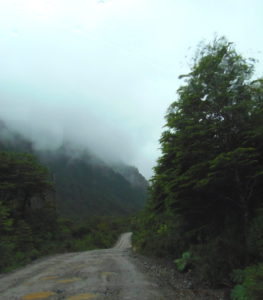
Whatever you think about the name, the Austral Highway runs through some of the most beautiful country on the planet. Chilean Patagonia is a land of mists and wind, of primordial forests,
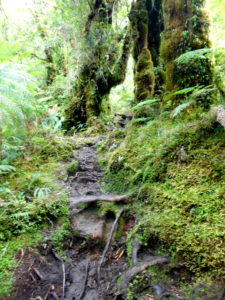
hanging glaciers
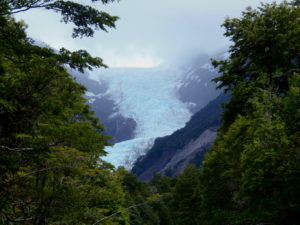
towering mountains,
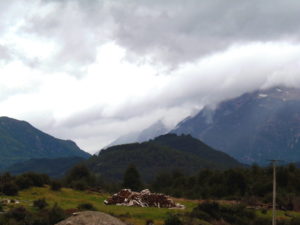
hidden waterfalls
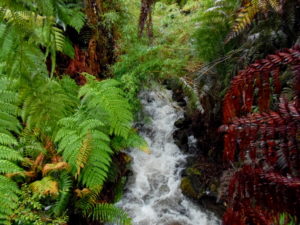
and plants with enormous, prehistoric-looking leaves.
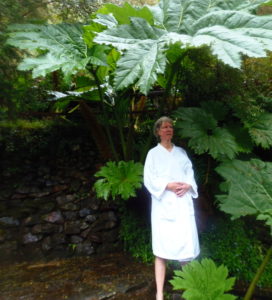
All of which you get a really good look at because the top speed on the Austral Highway is fifteen miles per hour.
Not that there are traffic cops down there to enforce speed limits, the gravel does that for you. Which means that, in a day of hard driving you can manage a hundred-and-twenty miles. Unless you come to a fjord and have to wait for the ferry.
There are fourteen fjords
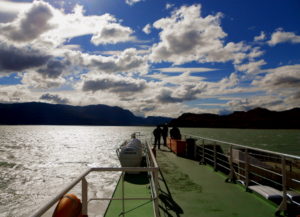
and the waits can be several hours. Even now, if something goes wrong in the south of the country, it takes the Chilean army weeks do get down there.
Slow as the road is, each day’s journey ends with a place to stay. It’s like the old Mission Trail into California, only instead of austere places run by monks who don’t believe in worldly pleasures, there are four and five-star hotels sporting such amenities as their own, private hot springs,
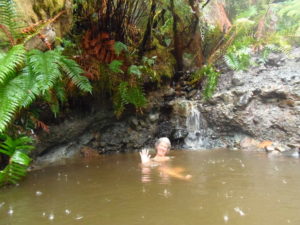
After a week, and about 500 miles of bumpy driving, we left the Austral Highway and headed inland, where we came across the pretty little town of Futaleufú. Its streets are lined with rustic-looking shops where you can arrange almost any imaginable outdoor activity. Fly-fishing. Trekking. Climbing. Skiing. Canyoning. Horseback riding. Rappelling. Canoeing. Hang gliding, if I remember right. And, along the border with Argentina, whitewater rafting on the Futaleufú River.
Whitewater rafting, Peggy and I thought, THAT sounds like fun.
“No dice,” announced the owner of the first shop after he’d gotten a good look at us . . . or whatever the Spanish for “no dice,” is.
As did the folks who ran the second rafting shop.
But the third shop . . . “that place looks American,” Peggy said, with no indication of why it looked less Chilean than any other place. But she’d perceived right. The whole staff, everybody inside, was American.
“You want to raft the Fu?” the proprietor asked. “How does bridge to bridge? Sound?”
In the category of Things I Wish I’d Known At The Time, bridge to bridge on the Futaleufú is right up there with discovering long after I’d ceased to be a Georgia teenager, that the whole time I’d been growing up the age of consent was thirteen. Despite what all those daddies would have had me believe, every one of their daughters was legal.
“Sure,” Peggy and I said, “Bridge to bridge sounds fine.”
Looking back, I’ve come to suspect that outfitters in South America aren’t so closely regulated as the ones back home. So, bridge to bridge it was and, the next day, she and I were bobbing in a rubber boat in a little cove at the foot of a bridge.
Along with us were two other customers, a guide, and a couple of guys in helmets paddling rescue kayaks. A pair of rescue kayakers and a guide seemed like overkill for four customers. Or, as we realized later, for Peggy and me, because the other two customers knew what they were doing, having just completed a four-day jaunt down a very wild river to the Pacific.
The day kicked off with a training session that involved Peggy hauling me back into the boat by the life jacket. Then my hauling her in while the kayak guys practiced rolls out in the river. After we’d proved we could haul each other back in if we fell off the boat, we got a very stern lecture about how, if we ever did fall off, do NOT swim back to the boat. It’s way too dangerous. Wait for a kayak to get you. And do NOT, the guide went on, try to swim to the bank. “Too many whirlpools for that.”
Then he pointed downriver, described the first set of rapids we’d be going through, and off we shot into a roaring freight train of crashing water, trying to paddle while the rescue kayaks plunged out of sight, then popped into the air like dolphins on sugar highs.
After what seemed like two or three highly adrenalized hours, but may have taken no more than about ten minutes, the guide steered us to a calm place behind some wicked looking rocks,
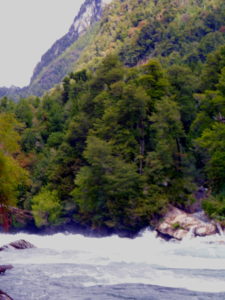
where we rotated in an eddy while he explained the next set of rapids.
Times like that are when I realize the value of professionals. The fact that he could distinguish where one rapids ended and the next began displayed a level of expertise way beyond anything Peggy and I brought to the experience. And, off we went again.
Toward the end of the morning we grounded on a rocky bar next to a curve we couldn’t see around.

He told us to keep to the center of the river, then swing right before going over the falls. Not that we couldn’t go over the falls on the left, only that we really, really did not want to do that. Now that he mentioned it, we could hear a roar from somewhere downriver.
Also, it was going to be very whirlpooly so if we fell out, don’t wait for a kayak, because they won’t be able to get to you. They’ll meet you half-a-mile downstream where the bodies surface. So, try not to fall out.
With the smashing and crashing, and the waterfall and whirlpools behind us, and the second bridge and the end of the journey in sight, the guide mentioned that he felt better, now.
Better? Had this guy been hungover the whole time?
“Nothing like that,” he assured us. “It’s just that I always feel like throwing up before running that last stretch.”
Good to know.
Something else we didn’t know was that the “American looking” shop we’d wandered into was owned by an Olympic kayaker named Chris Spelius. Or, almost an Olympic kayaker, because the Olympics where he’d been scheduled to kayak were in Moscow, and America boycotted the Moscow Olympics. Afterwards, he traveled to Patagonia, discovered the Futaleufú River, set up shop in town, and kicked off the entire outdoor-sports scene. And that the Fu is one of the five highest-rated whitewater rivers in the world.
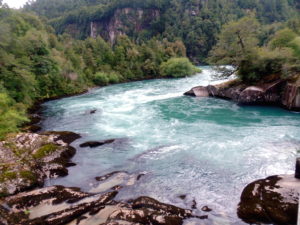
It’s wilder and faster than anything in North America. And bridge to bridge is one continuous run of Class IV/IV+ rapids, except for the Class V at the end which makes people who know the river want to throw up. But didn’t bother Peg and me much, because who knew?


No Comments